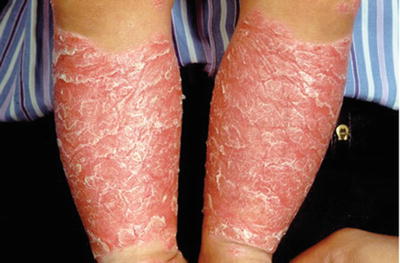Fig. 34.1
Well-defined salmon-coloured plaques, topped with silvery scales in chronic plaque psoriasis
Histologically, there is an increase in multiplication and turnover of keratinocytes. Three key features are a thickened parakeratotic epidermis (3–5× thicker), elongated dermal papillae with dilated tortuous capillaries, and sparse inflammatory infiltrate (mainly T-lymphocytes and some neutrophils) in the papillary dermis. There may be collections of neutrophils in the epidermis known as Munro’s micro-abscesses. These abscesses are sterile.
At the molecular level, there is a predominant Th1 lymphocyte proliferation leading to an increase in cytokines such as IL2, TNF-α, and IFN-γ.
Many studies have been published on psoriasis in the Caucasian population, much less non-Caucasian psoriasis.
This chapter concentrates on Asian paediatric psoriasis.
Asian skin [1] can be subdivided into:
(a)
South Asia—Pakistan, India, Sri Lanka
(b)
South-East Asia—Thailand, Malaysia, Singapore, Indonesia
(c)
East Asia—Japan, Korea, China
In paediatric Asian psoriasis patients (18 years and below), the peak incidence is at around 10 years with equal sex ratio.
A family history of psoriasis is present in about one-third of the cases. If one parent has psoriasis, there is a likelihood of 30 % that his or her child will have psoriasis. The risk goes up to 65 % with both parents involved [2].
Certain susceptibility genes have been mapped (Table 34.1).
Table 34.1
Susceptibility genes in psoriasis
Genes | Chromosome |
|---|---|
Psors 1 | 6q |
Psors 2 | 17q |
Psors 3 | 4q |
Psors 4 | 1q |
Psors 5 | 3q |
PSOR1 (psoriasis susceptibility 1) is the major gene determining the risk of psoriasis. It is located on the MHC site on chromosome 6, with the HLA-Cw6 allele imparting risk in both Caucasians and Asians.
In Han Chinese, HLA-Cw6 is found to be associated with susceptibility to psoriasis [3]. HLA-Cw6-positive patients tend to have early onset and more serious psoriasis. It also confers an increased risk of guttate psoriasis.
Thai studies have shown that HLA-Cw1-B46 carriers have greater nail involvement, and later age at onset as compared with HLA-Cw6 carriers [4].
Clinical Presentation
Asian paediatric psoriasis commonly presents as chronic plaques.
Joint and nail involvement is less common compared to adult psoriasis.
Koebner phenomenon is common and itch is milder in children.
The commonest presentation is chronic plaques psoriasis [5–9] The lesions commonly affect the scalp, the extensor surfaces of the limbs, and trunk (Figs. 34.2 and 34.3).



Fig. 34.2
Psoriasis tends to symmetrically affect the extensor aspect of the limbs

Fig. 34.3
Scalp psoriasis may be the first manifestation of psoriasis
Koebner phenomenon is present in 50 % and there is milder itch in children.
Nail and joint involvement is rare compared to adult psoriasis.
Data from multi-ethnic societies, e.g. Singapore, showed that Indians, compared to Malays and Chinese, tend to have a higher incidence of psoriasis [6].
A comparative trial in a multi-ethnic population in Singapore [10] (SG) against a predominantly Caucasian population in Netherlands (NL) revealed more Dutch children with an affected family member (73.3 % vs. 13.6 %). Presence of itch and triggering factors were more common among Dutch children (80 % vs. 14.2 % and 33.3 % vs. 7.4 %, respectively). Both groups shared similar triggering factors like stress and infections. Other similarities included mean age at presentation (NL group 11.3 years; SG group 14.1 years) and gender ratio (NL group, M/F 1:1.1; SG group, M/F 1:1.4). In both cohorts, plaque psoriasis was the most common type, with the head, followed by the limbs, being most involved. Similar proportions of children in both countries had nail involvement, and psoriatic arthritis was rare.
Aggravating factors include:
1.
Mechanical trauma—Koebner phenomenon
2.
Infection—streptococcal throat infection
3.
Drugs—lithium, beta-blockers, withdrawal of systemic steroids
4.
HIV infection
Differential Diagnosis
Table 34.2 lists the differential diagnoses of the morphological variants of psoriasis
Table 34.2
Morphological forms of psoriasis and differential diagnoses
Types | Differentials |
|---|---|
Chronic plaque | Discoid eczema Tinea corporis |
Guttate | Pityriasis rosea Pityriasis lichenoides Secondary syphilis |
Erythrodermic | Other endogenous eczema Drug eruption |
Localised pustular | Candidiasis Folliculitis |
Generalised pustular | Pustular drug eruption Acute generalised exanthematous pustulosis (AGEP) |
Palms and soles | Hand/feet eczema Dermatophytosis |
Scalp | Seborrhoeic dermatitis |
Nail | Lichen planus Onychomycosis |
Psoriatic arthropathy | Rheumatoid arthritis |
Psoriasis affects the nails. Nail changes include pitting (commonest change), distal onycholysis, subungual hyperkeratosis, discoloration (e.g. oil drop), and dystrophy. None of these clinical signs are pathognomonic of psoriasis.
Various forms of psoriatic arthritis are seen:
1.
Oligoarthritis—This affects less than five joints asymmetrically.
2.
Polyarthritis—Resembles rheumatoid arthritis
3.




Distal arthritis—This affects the distal inter-phalangeal joints of the hands and feet
Stay updated, free articles. Join our Telegram channel

Full access? Get Clinical Tree


